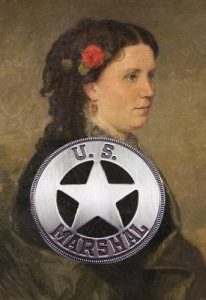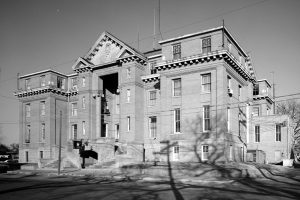 The Old West was a wild, untamed place, and the people who lived there had to be tough as nails too. During that time, the Indian Territory, now Oklahoma, was considered the most violent of the American territories. Along with the Indians, it served as home to hundreds of outlaws from around the country. These were hardened criminal men, accused of murder, rape, robbery, arson, adultery, bribery, and numerous other crimes. They headed to the Indian Territory, looking for a place to hideout…a place where the lawmen couldn’t follow. The Indian Territory was without law enforcement with the exception of the Indian Nations’ police forces, who had no jurisdiction over the many criminals who had taken flight from other states. It left the outlaws in a place of sweet freedom, from both types of law.
The Old West was a wild, untamed place, and the people who lived there had to be tough as nails too. During that time, the Indian Territory, now Oklahoma, was considered the most violent of the American territories. Along with the Indians, it served as home to hundreds of outlaws from around the country. These were hardened criminal men, accused of murder, rape, robbery, arson, adultery, bribery, and numerous other crimes. They headed to the Indian Territory, looking for a place to hideout…a place where the lawmen couldn’t follow. The Indian Territory was without law enforcement with the exception of the Indian Nations’ police forces, who had no jurisdiction over the many criminals who had taken flight from other states. It left the outlaws in a place of sweet freedom, from both types of law.
Then Judge Isaac Parker was appointed to the Western Judicial District of Arkansas, which included Indian Territory. All that sweet freedom was about to end. Parker decided to bring law and order to the Indian Territory…or at least to the criminal element of it. He commanded about 200 deputy marshals to “clean up” the lawless territory. It was a noble idea that would take years to accomplish, as the deputies struggled to cover some 74,000 square miles in their search for hundreds of wanted fugitives. The occupation of a U.S. Deputy Marshal courted constant danger, so much so that between 1872 and 1896, over 100 deputies died enforcing the law throughout the territory. A number of men made names for themselves working as U.S. Marshals in the Indian Territory. Men such as Heck Thomas, Bass Reeves, Bill Tilghman, Chris Madsen, and dozens of others.
There were also a number of other U.S. Marshals who, more quietly made names for themselves, mainly because they were women. I think that as a woman, I would not be so inclined to head into Indian Territory in those days to “clean up” the place. Women have long been considered a part of the “clean up” crew, but most of the time, it was as homemakers. I don’t think anyone thought they could be successful law enforcement officers…at least not in those days.
One of these brave women was F.M. Miller, who was appointed as a U.S. Deputy Marshal out of the federal court at Paris, Texas in 1891. When she was commissioned, she was the only female deputy working in Indian Territory. She was known to have accompanied Campbell on all his trips. During her tenure, she was mentioned in several newspaper articles including the Fort Smith Elevator on November 6, 1891 that described here as: “a dashing brunette of charming manners.” The article continued by stating: “The woman carries a pistol buckled around her and has a Winchester strapped to her saddle. She is an expert shot and a superb horsewoman, and brave to the verge of recklessness. It is said that she aspires to win a name equal to that of Belle Starr, differing from her by exerting herself to run down criminals and in the enforcement of the law.”
Another article appeared a couple of weeks later in the Muskogee Phoenix on November 19, 1891, which said that she had the reputation of being a fearless and efficient officer and had locked up more than a few offenders. The article continued: “Miss Miller is a young woman of prepossessing appearance, wears a cowboy hat and is always adorned with a pistol belt full of cartridges and a dangerous looking Colt pistol which she knows how to use. She has been in Muskogee for a few days, having come here with Deputy Marshal Cantrel, a guard with some prisoners brought from Talahina. Regarding Miss. Miller’s unique position as Deputy U.S. Marshal, another newspaper commented, “Hopefully in the future, there will be more information on this colorful peace officer.”
Another female U.S Marshal in Indian Territory who showed bravery and skill in her job was a young woman named Ada Curnutt. The daughter of a Methodist minister, Ada Curnutt moved to the Oklahoma Territory with her sister and brother-in-law shortly after it opened for settlers. The 20 year old soon found work as the Clerk of the District Court in Norman, Oklahoma and as a Deputy Marshal to U.S. Marshal William Grimes. Her most famous arrest occurred in March, 1893 when she received a telegram from Grimes, instructing her to send a deputy to Oklahoma City to bring in two notorious outlaws named Reagan and Dolezal who were wanted for forgery. I seriously doubt that Grimes meant for her to go, but all the other deputies were out in the field so Curnutt stepped up to the responsibility. She quickly boarded a train for Oklahoma City. When she arrived she discovered that the two men were in a saloon and quickly made her way there. Upon her arrival she asked a man on the street to go in and tell them that a lady needed to see them outside. The outlaws eagerly went out to meet her. When the two emerged, Ada read the warrants to them and stated that they were under arrest. Heavily armed, the two men laughed at the young woman and thinking it was a joke. They stupidly allowed her to place handcuffs over their wrists. When the captives began to realize that the joke was on them, Curnutt announced to the crowd gathered around them that she was prepared to deputize every man to aide her, if needed. As it turns out, it was not necessary, as she escorted them to the the train station and telegraphed the marshal’s office in Guthrie that she was bringing them in. She was 24 years old at the time. The two forgers  were soon tried and convicted. “Like all deputies of her era, she had to be extremely tough and ready to face a wide range of situations,” the U.S. Marshals Service wrote of Carnutt.
were soon tried and convicted. “Like all deputies of her era, she had to be extremely tough and ready to face a wide range of situations,” the U.S. Marshals Service wrote of Carnutt.
While it was unusual, there were a number of women in law enforcement, even before it was widely accepted as normal. All these women forged the way for the many women we have in law enforcement, and even in the military today. these women may have been the “clean up” crew, but they were a tough as nail clean up crew, and they made, and continue to make, history in the field of law enforcement, and in the military.


Leave a Reply